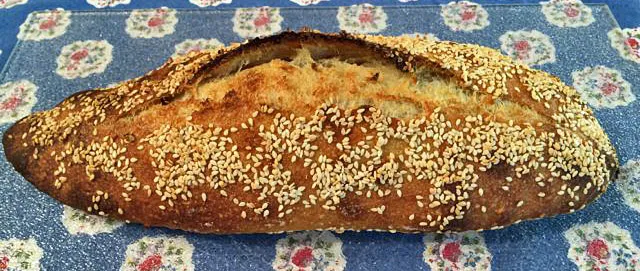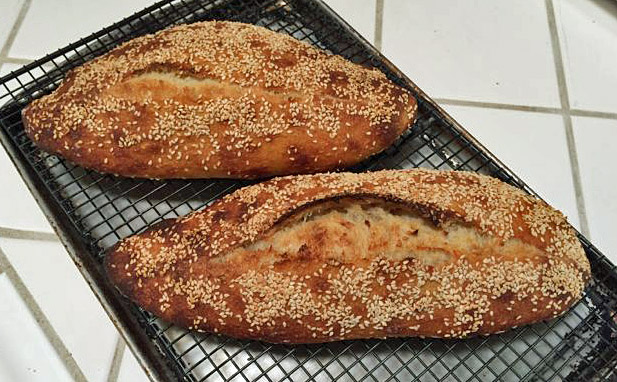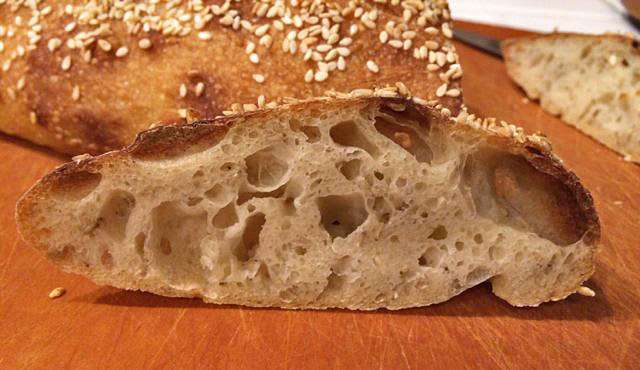
Semolina Capriccioso
DMSnyder
March 25, 2016
This bread combines many streams of inspiration – my own Pugliese Capriccioso and San Joaquin Sourdough, Hamelman's Semolina Bread and Tom Cat's Semolina Filone, as described by Maggie Glezer in “Artisan Baking.”
This is a high hydration dough that is a challenge to mix and shape. Because it was so gloppy, even after machine mixing and multiple stretch and folds in the bowl, I decided to retard the dough in bulk and use the techniques and timing of the San Joaquin Sourdough for shaping and proofing. I had intended to coat the loaves with sesame seeds before proofing, but – again because of how loose the dough was – opted to load onto parchment after proofing and apply the seeds by brushing with water and sprinkling the seeds onto the loaves.
Total Dough Ingredients | Wt (g) | Baker's % |
AP flour | 223 | 40 |
Fine durum flour | 334 | 60 |
Water | 446 | 80 |
Salt | 11 | 2 |
Sesame seeds, toasted | 29 | 5 |
Sesame seeds (un-toasted) to coat loaves |
|
|
Total | 1043 | 187 |
20% of the flour is pre-fermented.
Biga Naturale Ingredients | Wt (g) | Baker's % |
Fine durum flour | 97 | 100 |
Water | 48 | 50 |
Active starter (50% hydration) | 21 | 22 |
Total | 166 | 172 |
The day before baking, mix the biga.
Ferment until doubled in volume at 76ºF.
Refrigerate overnight
Final Dough Ingredients | Wt (g) |
AP flour | 223 |
Fine durum flour | 223 |
Water (Warm - 80-85ºF) | 391 |
Salt | 11 |
Biga naturale | 166 |
Sesame seeds, toasted | 29 |
Total | 1043 |
Method
Take the biga out of the refrigerator and let it warm up for about an hour.
Mix the water and flours to a shaggy mass, cover and autolyse for 20-60 minutes.
Sprinkle the salt on the dough and add the biga in chunks.
Mix at Speed 1 for 1-2 minutes until the ingredients are well-mixed.
Mix at Speed 2 for about 10 minutes. The dough will be quite slack. It will not clean the sides of the bowl but will form a ball on the dough hook,. A large portion of the dough will still be on the bottom of the bowl.
Add the toasted sesame seeds to the dough, and mix on low speed for a couple minutes to distribute them.
Transfer the dough to a lightly oiled bowl with a tight-fitting cover.
Ferment at 76ºF for 2 1/2 to 3 hours with a stretch and fold in the bowl every 30 minutes.
The dough will not expand much, but, if fermented in a clear container, tiny bubbles should be seen throughout it.
Cold retard the dough at about 40ºF until the next morning (8-18 hours).
Divide the dough into two equal pieces. Pre-shape into balls, cover, and let the dough rest for 50-60 minutes.
Shape the pieces as boules or bâtards.
If bâtards: Place the loaves on a linen couche seam-side up and cover. If boules: Place the loaves in a well-floured banneton, seam-side up, and cover.
Proof at room temperature until the dough springs back slowly when you poke a finger into it. (About 40 minutes)
45-60 minutes before baking, preheat the oven to 500ºF with a baking stone and steaming apparatus in place.
Transfer the loves seam-side down to a piece of parchment paper the size of your baking stone and slide a peel under it.
Brush the loaves with water and sprinkle them with sesame seeds. Score the loaves as desired.
Steam the oven and turn the temperature down to 460ºF.
Transfer the loaves to the baking stone.
After 12 minutes, remove the steaming apparatus. (If you have an electric convection oven, switch to Convection Bake and turn the temperature down to 440ºF.) Bake for another 14 minutes or until the loaves are done. The crust should be nicely colored. The internal temperature should be at least 205ºF.
(Optionally) Leave the loaves on the baking stone with the oven turned off and the door ajar for another 10 minutes to dry the crust.
Transfer the loaves to a cooling rack. Cool completely before slicing.


After the loaves had cooled, the crust was soft. On slicing, the crumb was moderately open. The crust and crumb were quite chewy. The flavor was sweet and nutty.
I cut a bite-sized piece for my wife who was up to her elbows in washed lettuce for our dinner salad. “Mmmmm ….,” says she. “Why are we making all this other food?”
This is a delicious bread. It has earned top ranking among my Italian-style sourdough breads. I may try making it with a somewhat lower hydration. Might try “shaping” this dough as Ciabattas. It should be tried as rolls as well. Gonna be a fun set of experiments!
Happy baking!
David
- dmsnyder's Blog
- Log in or register to post comments
"It has earned top ranking among my Italian-style sourdough breads", you say? So now what am I supposed to do? I already love love love your SD Italian sesame semolina bread, but you rank this above that bread? The crumb on this bread looks fantastic as you almost always get a more open crumb structure than I do. Hmm, I know that velvet glove is around here somewhere...
Well, I guess I'll just have to see what all the hubbub on this bread is about ;-) . I'm committing to trying to French Fold this, although I may have to resign myself to dropping it in the mixer halfway through. We shall see. Thanks for publishing this one David.
alan
This one has a lot in common with the SD Italian bread. The most significant differences are 1) Use of a durum-fed biga, 2) Toasted sesame seeds in the dough, 3) Yet higher hydration, 4) No added olive oil or sweetener.
The two breads are quite similar in flavor with obvious differences due to the above. I would like you to try this new version and let us know what you think.
As I implied in the OP, this is a work in progress. I have a number of variations I want to try.
David
Hello and hope you are well . Beautiful bread and lovely crumb. Anything with toasted sesame seeds always has my vote !!
As an aside I have had Bread for years and years and almost never ever use it. Due to your references in your posts I have made it a habit to use Bread for all my baking in 2016. So far I am very pleased. I have to add the measurements in metrics and add in autolyse on each formula as he doesn't talk about it except in the front of the book. His formulas are right on and so far all the ryes I have made have been very good. Thanks for the prodding..unbeknownst to you of course ! Caroline
How nice to hear from you! I am quite well, thank you.
A hint re. using Hamelman's formulas at home: If you take his metric measure version and divide each ingredient's weight by 10, you have a quantity suitable for home baking. This is way easier than converting the provided home version to metric weights.
Since you confess to prodability (Yay! My first neologism of the week!), and if you are enjoying Hamelman's high-rye percentage breads, do try the Berliner Landbrot that Stan Ginzburg has posted. It is super easy and super yummy.
Happy baking!
David
I think I noted that mathematical solution years ago and then payed no mind to it this time !! Will definitely implement as I move through the book.
The probability of my prodabilty is very high :) I shall try the Berliner...and post back. Needed prodding by Dab to start posting pics again. Thank you c
Thanks David for posting the easy approach to altering the recipes in Hamelman's "Bread." It is a great book and I use it often…in fact, I made his semolina bread with the toasted sesame seeds for St. Joseph's Day. It is a wonderful bread. I look forward to trying your recipe sometime soon. Happy Easter! Happy Spring! Embth
wondering what makes these both 'Capriccioso'. Would they both be found in Capri? What a nice crumb too! The AP helped there. Less water might tighten it up some while making it easier to handle like you say and another 5%-10% water or so and the ciabatta would be right there. Do Italians ever put grappa in bread. I can't say i have ever seen a recipe with it in bread - maybe a bit too harsh:-) Another nice one David and we can't wait to see what you do with it.
Happy baking
Capri? I always assumed the Isle of Capri was named for it's goats, but I dunno. "Capriccioso/a means "playful" or "willful" in Italian. When attached to a prepared food, it implies that it was prepared according to the cook's whim of the moment. That's how I mean it.
Now, goats are, indeed, playful. So, maybe Capri and Capriccioso/a have the same root. ..... Well, Webster's Unabridged Dictionary (Yeah! On paper!) says all those capri- words derive from the Latin for goat. But some believe that the Isle of Capri's name derives from Kapros, the Greek word for wild boar. So, choose your preferred critter.
Never heard of grappa in bread. The alcohol would evaporate when the bread is baked. What a waste!
David
poor Lucy's brain :-) Now that is a waste!
Very nice loaf David. I usually don't put the sesame seeds inside the dough for my versions but I like the idea and will have to try that next time. If you can get your hands on some smoked sesame seeds I think you may like them inside and outside of this one.
Regards,
Ian
Hamelman has at least two formulas that call for sesame seeds in the dough. They do add a nutty flavor tone, a natural with durum flour.
I never heard of smoked sesame seeds. If they taste smoked, my wife would not like them but I would. I'm curious as to how these are traditionally used and in what type of cuisine.
David
I found them at Home Goods and I'm glad I did. They are bamboo smoked. Not sure what traditional food or type of cuisine they are intended, but I do know they taste great on and in bread. I am using some on a Kamut bread I have in the oven right now. I should have put them inside but I didn't read your post until I already mixed the dough :).
Regards,
ian
Looks fantastic and must taste great as well. I will have to try this one too. My to bake list is getting longer. . . I do love the snap that the durham flour adds to the crust.
Happy Easter and happy baking! Ski